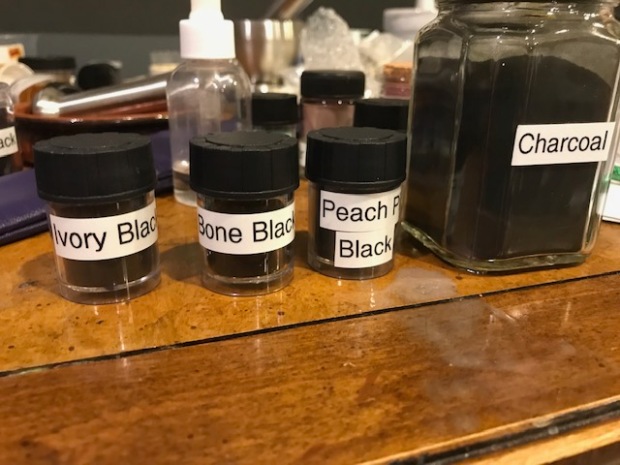
I have been waiting for a good conditions to try making a few new black pigments. I had received some mammoth ivory scraps from a friend and had been saving chicken bones to make ivory and bone black pigments. These pigments were used in prehistory into the medieval ages and much farther. Rembrandt often used bone black paint. Ivory black is mentioned in the Marciana Manuscript in Merrifield’s Medieval and Renaissance Treatises on the Art of Painting:
- Black
Take peach stones and char them, or burn ivory, which will make perfect black, &c.
To make my pigments, I purchased a piece of pipe (1 1/4 black pipe nipple) with two end caps. I put my material, first ivory and then chicken bones, into the pipe and screwed on the end caps so I had a type of “crucible.” I then placed this crucible into a very hot fire with some nice coals. I allowed the crucible to sit in the fire for approximately an hour. After this time, I used tongs to remove the crucible from the fire and allowed it to cool a bit before opening it and emptying the contents into a dish. I could then refill the crucible and put it back into the fire.
The charred material was black all the way through and much more brittle than the uncharred material. I was impressed with how much pigment came from the small amount of charred material I had made.
I have since ground both pigments, but have yet to make paint with the bone black. The ivory black has brown tones.
Next up, and probably last of the black pigments, will be almond shells made in a similar way.
*A note on mammoth ivory: I used mammoth ivory due to many other ivories rightly protected by CITES (Convention on International Trade in Endangered Species). Mammoth ivory is legal since the trade does not decrease the population of an extinct species. Some estimate that more than 10 million mammoths lie frozen in Siberia. These ivory tusks have begun to mineralize but are not fully fossilized.






2 Comments